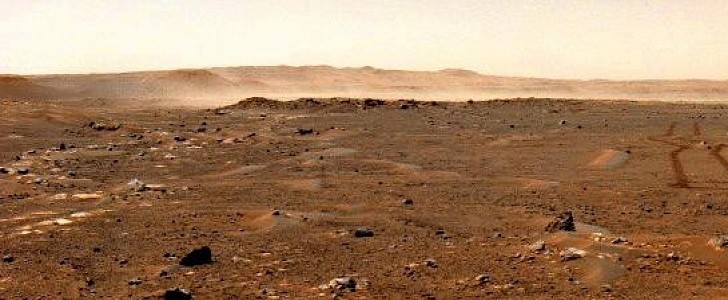We know that Mars isn't exactly a friendly place to be for solar-powered spacecraft. The massive dust storms that often engulf the planet can pose serious threats to the rovers, as well to future expeditions. That's why NASA's Perseverance has been monitoring dust activity in the Jezero Crater.
Perseverance landed in the Jezero Crater on February 18, 2021. Since then, the car-sized rover has been busy snapping pictures of the alien landscape, collecting samples, and searching for signs of ancient microbial life.
With the help of MEDA (Mars Environmental Dynamics Analyzer), Perseverance also monitors dust from the surface of Mars. During its first hundred days on the Red Planet, it encountered intense dust activity on the planet. It detected hundreds of dust devils, and it captured footage of wind gusts raising a massive dust cloud.
Recently, a team of scientists studied the phenomenon closely. They recently published a paper on the wind activity recorded by Perseverance in its first 216 days on Mars in Science Advances. The team discovered that during a Martian day, Perseverance has an encounter with at least four whirlwinds.
Moreover, they found that shortly after noon, more than one per hour passes the rover. The largest of them even produced a massive cloud that covered 1.5 sq miles (4 sq km), making it the first such wind-lifted dust cloud recorded by a rover on Mars.
Researchers also believe that on Jezero, dust activity is more intense. This might be due to the crater's proximity to the "dust storm track," a path that goes across the planet from north to south that frequently lifts dust particles.
This dusty situation is actually more serious than previously anticipated in the Jezero Crater. Although Perseverance is nuclear-powered, the rover's exposed instruments can get clogged up or get damaged. MEDA's two wind sensors are thought to have been damaged by sand grains.
"We collected a lot of great science data," said Manuel de la Torre Juarez, MEDA's deputy principal investigator at JPL. "The wind sensors are seriously impacted, ironically, because we got what we wanted to measure."
Currently, the team is evaluating software upgrades that should allow the wind sensors to continue to function. The new discoveries will help scientists better understand dust activity on Mars. Researchers hope that they will one day be able to predict the dust storms that could harm future spacecraft and astronauts.
With the help of MEDA (Mars Environmental Dynamics Analyzer), Perseverance also monitors dust from the surface of Mars. During its first hundred days on the Red Planet, it encountered intense dust activity on the planet. It detected hundreds of dust devils, and it captured footage of wind gusts raising a massive dust cloud.
Recently, a team of scientists studied the phenomenon closely. They recently published a paper on the wind activity recorded by Perseverance in its first 216 days on Mars in Science Advances. The team discovered that during a Martian day, Perseverance has an encounter with at least four whirlwinds.
Moreover, they found that shortly after noon, more than one per hour passes the rover. The largest of them even produced a massive cloud that covered 1.5 sq miles (4 sq km), making it the first such wind-lifted dust cloud recorded by a rover on Mars.
Researchers also believe that on Jezero, dust activity is more intense. This might be due to the crater's proximity to the "dust storm track," a path that goes across the planet from north to south that frequently lifts dust particles.
This dusty situation is actually more serious than previously anticipated in the Jezero Crater. Although Perseverance is nuclear-powered, the rover's exposed instruments can get clogged up or get damaged. MEDA's two wind sensors are thought to have been damaged by sand grains.
"We collected a lot of great science data," said Manuel de la Torre Juarez, MEDA's deputy principal investigator at JPL. "The wind sensors are seriously impacted, ironically, because we got what we wanted to measure."
Currently, the team is evaluating software upgrades that should allow the wind sensors to continue to function. The new discoveries will help scientists better understand dust activity on Mars. Researchers hope that they will one day be able to predict the dust storms that could harm future spacecraft and astronauts.





